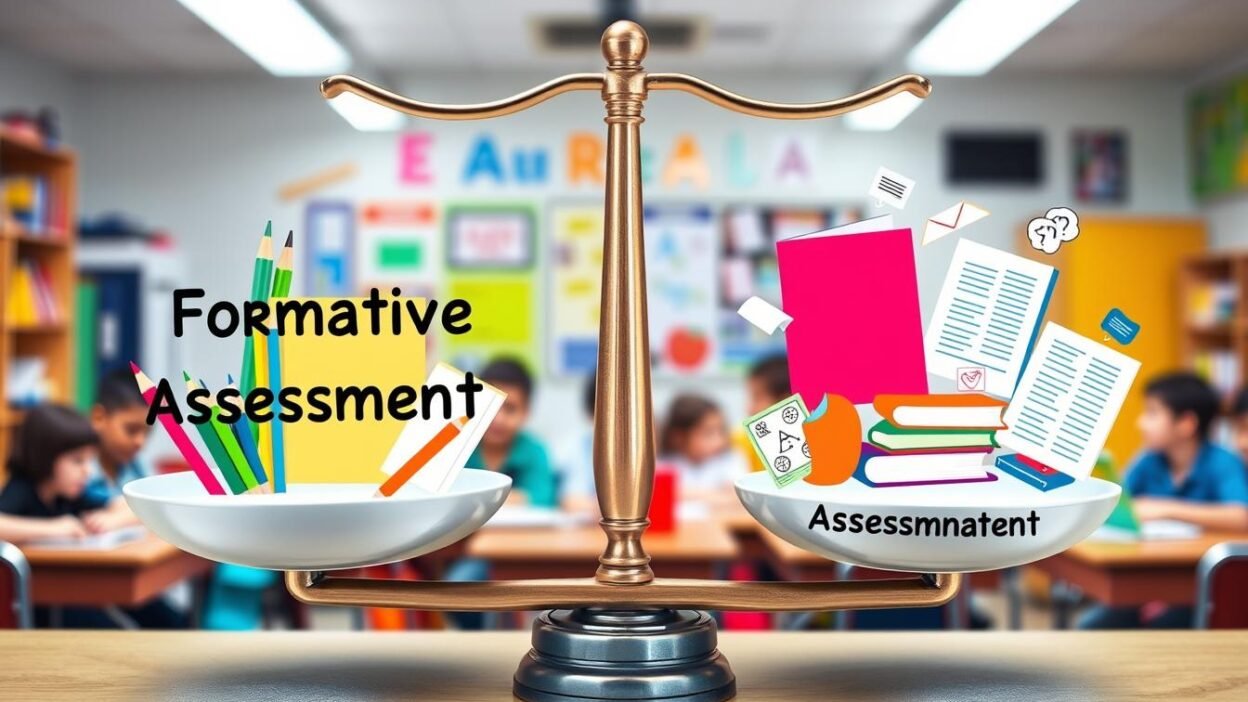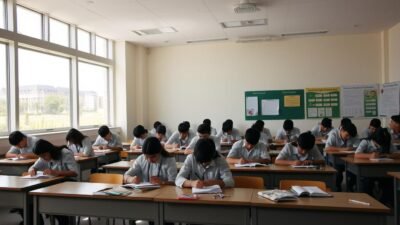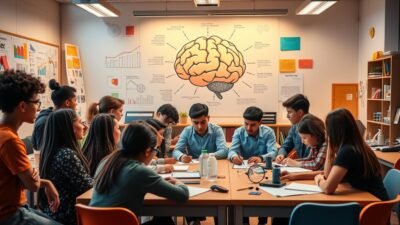Are traditional testing methods truly capturing the full spectrum of student learning? In the realm of UGC NET Education, this question sparks a crucial debate about assessment strategies. As educators, we’re tasked with finding the sweet spot between ongoing feedback and final evaluations. This balancing act shapes not only our teaching methodologies but also influences educational psychology in profound ways.
The journey through effective assessment techniques is vital for every teacher. It’s about understanding how to gauge progress while fostering growth. From quick quizzes to comprehensive exams, each tool in our assessment toolkit serves a unique purpose. Let’s explore how to harmonize these approaches to create a robust learning environment.
Key Takeaways
- Formative and summative assessments serve different yet complementary roles
- UGC NET Education framework emphasizes balanced assessment strategies
- Effective assessments improve teaching methodologies and student outcomes
- Educational psychology insights guide assessment design and implementation
- Balancing ongoing feedback with final evaluations enhances learning experiences
Understanding Formative and Summative Assessments
In curriculum development, learning assessment plays a crucial role. Two key types of assessments shape the education landscape: formative and summative. Let’s explore these essential tools that support inclusive education practices.
Definition of Formative Assessments
Formative assessments are ongoing evaluations that track student progress during the learning process. These regular check-ins help teachers adjust their instruction to meet student needs. Examples include class discussions, quizzes, and peer reviews.
Definition of Summative Assessments
Summative assessments measure student achievement at the end of a unit or course. They evaluate overall learning outcomes and often contribute to final grades. Common forms include final exams, term papers, and standardized tests.
Key Differences Between Them
While both types of assessments are vital for inclusive education, they serve different purposes in curriculum development. Here’s a comparison:
| Aspect | Formative Assessment | Summative Assessment |
|---|---|---|
| Timing | During learning process | End of learning unit |
| Purpose | Guide teaching and learning | Evaluate overall achievement |
| Feedback | Immediate and specific | Often delayed and general |
| Stakes | Low-stakes, less pressure | High-stakes, more formal |
By understanding these assessment types, educators can create a balanced approach to learning assessment that supports all students in their educational journey.
Importance of Assessment in Education
Assessment plays a vital role in education. It shapes learning experiences and guides teaching methodologies. In educational psychology, assessments are key tools for understanding student progress and tailoring instruction.
Role of Assessments in Learning
Learning assessment helps students gauge their understanding. It pinpoints areas for improvement and celebrates achievements. Teachers use assessments to track progress and adjust their teaching strategies.
Impact on Student Motivation and Engagement
Well-designed assessments boost student motivation. They provide clear goals and a sense of accomplishment. When students see their progress, they engage more deeply with the material.
| Assessment Type | Motivation Impact | Engagement Level |
|---|---|---|
| Quizzes | Medium | High |
| Projects | High | Very High |
| Self-Reflection | High | Medium |
Enhancing Teaching Strategies Through Feedback
Feedback from assessments is crucial for refining teaching methodologies. It helps educators identify effective approaches and areas needing improvement. This continuous cycle of assessment and adjustment leads to more effective learning experiences for students.
“Assessment is not just about measuring learning; it’s about creating opportunities for growth and improvement.”
Techniques for Formative Assessments
Formative assessments play a crucial role in modern teaching methodologies. These techniques help educators gauge student understanding and adjust their instruction accordingly. Let’s explore some effective formative assessment strategies that support inclusive education.
Observational Assessments
Teachers can gain valuable insights by observing students during class activities. This method allows for real-time evaluation of student engagement and comprehension. Educators can use checklists or rubrics to track progress and identify areas needing attention.
Quizzes and Polls
Educational technology has revolutionized the way we conduct quizzes and polls. Digital platforms enable teachers to create interactive assessments that provide instant feedback. These tools can be used to:
- Check understanding of key concepts
- Gauge student opinions on topics
- Identify common misconceptions
By using these tech-enhanced assessments, teachers can quickly adapt their lessons to meet student needs.
Peer Assessment Strategies
Peer assessment fosters collaboration and critical thinking skills. Students evaluate each other’s work using predetermined criteria. This approach not only provides valuable feedback but also deepens understanding of the subject matter. Implementing peer assessments can be particularly effective in inclusive education settings, as it promotes diverse perspectives and mutual learning.
“Peer assessment empowers students to take ownership of their learning journey.”
By incorporating these formative assessment techniques, educators can create a dynamic and responsive learning environment that caters to all students’ needs.
Techniques for Summative Assessments
Summative assessments play a crucial role in learning assessment and curriculum development. These evaluations help measure student progress and inform educational administration decisions. Let’s explore some effective techniques used in summative assessments.
Standardized Testing Overview
Standardized tests are widely used in educational systems. These exams provide a consistent way to measure student performance across different schools and regions. While they offer valuable data, it’s important to balance them with other assessment methods.
Project-Based Assessments
Project-based assessments allow students to demonstrate their knowledge through practical applications. This approach aligns with modern curriculum development strategies, encouraging critical thinking and problem-solving skills. Students might create a portfolio, conduct research, or develop a product to showcase their learning.
Portfolios as a Summative Tool
Portfolios offer a comprehensive view of a student’s progress over time. They can include various work samples, reflections, and achievements. This method supports ongoing learning assessment and provides rich insights for educational administration.
- Showcases student growth
- Encourages self-reflection
- Provides a holistic view of learning
By using a mix of these techniques, educators can create a well-rounded assessment strategy that supports effective curriculum development and learning assessment practices.
Integrating Technology in Assessments
Educational technology transforms assessment practices in modern classrooms. Teachers now use digital tools to gauge student understanding and track progress more efficiently.
Digital Formative Assessment Tools
Apps like Kahoot! and Quizizz make quick checks fun and engaging. These platforms let teachers create interactive quizzes that students can answer on their devices. Real-time results help educators adjust their teaching methodologies on the fly.
Online Platforms for Summative Assessments
For end-of-unit tests, platforms like Google Forms and Canvas offer robust features. They allow for various question types and automatic grading. This saves time and provides instant feedback to students.
Benefits of Tech-Enhanced Assessments
Tech-enhanced assessments bring many advantages to the classroom:
- Immediate feedback for students
- Data analysis for teachers
- Personalized learning paths
- Reduced grading time
These benefits align with UGC NET Education standards, emphasizing the importance of effective assessment strategies in teaching.
| Assessment Type | Traditional Method | Tech-Enhanced Method |
|---|---|---|
| Formative | Paper quizzes | Interactive apps |
| Summative | Written exams | Online tests |
| Feedback | Days later | Instant |
By embracing these tools, educators can create a more dynamic and responsive learning environment. This approach not only improves assessment accuracy but also enhances student engagement and learning outcomes.
Aligning Assessments with Learning Objectives
Effective curriculum development hinges on the alignment of assessments with learning objectives. This process ensures that what students learn matches what they’re tested on, creating a cohesive educational experience.
Designing Assessments to Reflect Goals
In educational psychology, designing assessments that reflect learning goals is crucial. This approach helps teachers gauge student progress accurately. A well-designed assessment:
- Measures specific skills or knowledge
- Provides clear expectations for students
- Offers valuable feedback for improvement
Backward Design in Curriculum Planning
Backward design is a key strategy in curriculum development. It starts with the end goal in mind, working backwards to create lessons and activities. This method ensures that learning assessments align perfectly with educational objectives.
| Step | Action | Outcome |
|---|---|---|
| 1 | Identify desired results | Clear learning objectives |
| 2 | Determine acceptable evidence | Appropriate assessment methods |
| 3 | Plan learning experiences | Engaging lessons and activities |
By following this process, educators can create a robust curriculum that seamlessly integrates learning objectives, teaching strategies, and assessments. This approach not only enhances student learning but also provides valuable insights for ongoing curriculum improvement.
Feedback Mechanisms in Assessments
Feedback plays a crucial role in shaping teaching methodologies and supporting inclusive education. Effective feedback mechanisms can significantly impact student learning and growth.
Importance of Timely Feedback
Timely feedback is essential in educational psychology. It helps students understand their progress and areas for improvement quickly. When teachers provide prompt feedback, students can make immediate adjustments to their learning strategies.
Strategies for Effective Feedback
To ensure effective feedback, teachers can use various strategies:
- Specific and actionable comments
- Positive reinforcement
- Goal-oriented suggestions
- Personalized feedback tailored to each student’s needs
Utilizing Peer Feedback
Peer feedback is a valuable tool in inclusive education. It encourages students to learn from each other and develop critical thinking skills. Teachers can implement peer feedback through group projects, peer reviews, and class discussions.
| Feedback Type | Benefits | Challenges |
|---|---|---|
| Teacher Feedback | Expert guidance, personalized attention | Time-consuming, potential bias |
| Peer Feedback | Collaborative learning, diverse perspectives | Varying quality, need for guidance |
| Self-Assessment | Promotes reflection, self-awareness | Subjectivity, lack of external input |
By incorporating these feedback mechanisms, educators can enhance their teaching methodologies and create a more inclusive learning environment for all students.
Challenges Faced in Assessments
Educators encounter various hurdles when evaluating students. These challenges stem from the complex interplay of educational psychology, inclusive education practices, and education policies. Let’s explore some key issues and potential solutions.
Student Anxiety and Performance
Test anxiety can significantly impact student performance. Educational psychology research shows that stress can hinder cognitive function and recall. To address this, schools can implement relaxation techniques and provide support systems for anxious learners.
Ensuring Fairness and Equity
Creating fair assessments for all students is crucial. Inclusive education policies aim to level the playing field. This involves designing tests that account for diverse backgrounds and learning styles. Schools can use varied assessment methods to give every student a chance to shine.
Addressing Diverse Learning Needs
Students have different strengths and challenges. Inclusive education requires tailoring assessments to meet these varied needs. This might include offering extra time, providing assistive technology, or allowing alternative response formats.
| Challenge | Solution |
|---|---|
| Test Anxiety | Relaxation techniques, Practice tests |
| Fairness Issues | Diverse assessment methods, Cultural sensitivity |
| Learning Differences | Accommodations, Assistive technology |
By tackling these challenges head-on, educators can create a more equitable and effective assessment system. This approach aligns with modern education policies and fosters a supportive learning environment for all students.
Professional Development for Educators
Effective teacher training is key to improving assessment practices in education. Educators need ongoing professional development to stay current with the latest techniques and strategies.
Training on Assessment Techniques
Educational administration plays a crucial role in organizing workshops focused on formative and summative assessment methods. These sessions help teachers learn how to create fair and meaningful tests aligned with learning goals.
Encouraging Collaborative Planning
Schools promote teamwork among teachers to develop assessment plans. By sharing ideas, educators create more diverse and engaging ways to measure student progress. This collaborative approach leads to better outcomes for both teachers and students.
Staying Informed on Best Practices
Keeping up with the latest research is vital for educators. Many turn to resources like UGC NET Education guidelines to enhance their knowledge of assessment strategies. Online courses and webinars offer flexible options for busy teachers to learn new skills.
| Professional Development Activity | Benefits |
|---|---|
| Assessment workshops | Learn new techniques, improve test design |
| Collaborative planning sessions | Share ideas, create diverse assessments |
| UGC NET Education resources | Stay updated on best practices, enhance skills |
By investing in these professional development areas, schools can significantly improve their assessment practices and student learning outcomes.
Future Trends in Educational Assessments
The landscape of educational assessments is evolving rapidly. New trends are shaping how we evaluate student learning and skills. These changes align with modern education policies and curriculum development strategies.
Shifts Towards Competency-Based Assessments
Competency-based assessments focus on measuring specific skills and knowledge. This approach allows students to progress at their own pace. It’s gaining traction in schools across India as part of new education policies.
Adaptive Assessment Technologies
Educational technology is transforming how we test students. Adaptive assessments use AI to adjust questions based on student responses. This provides a more accurate picture of a student’s abilities and helps tailor instruction.
| Traditional Assessments | Adaptive Assessments |
|---|---|
| Fixed set of questions | Dynamic questions based on responses |
| One-size-fits-all approach | Personalized difficulty level |
| Limited feedback | Detailed insights on strengths and weaknesses |
Emphasis on Holistic Evaluations
There’s a growing trend towards holistic assessments in curriculum development. These evaluate not just academic knowledge, but also skills like critical thinking and creativity. This shift reflects a broader view of student success in modern education policies.
“The future of assessment lies in understanding the whole student, not just their test scores.”
As educational technology advances, we can expect more innovative assessment methods. These will better support student learning and guide curriculum development in the years to come.
Conclusion: Achieving Balance in Assessment Strategies
Balancing formative and summative assessments is key to effective learning. This approach aligns with UGC NET Education standards and enhances teaching methodologies. Educators can use a mix of quizzes, projects, and portfolios to gauge student progress and understanding.
Recap of Key Techniques
We’ve explored various assessment tools, from observational techniques to tech-enhanced evaluations. These methods cater to diverse learning needs and provide valuable insights into student performance. Integrating both formative and summative assessments creates a comprehensive learning assessment framework.
Call to Action for Educators
It’s time for educators to embrace these balanced assessment strategies. By implementing a mix of ongoing feedback and final evaluations, teachers can foster a more engaging and effective learning environment. This approach not only improves student outcomes but also aligns with modern educational best practices.
Let’s commit to refining our teaching methodologies and assessment techniques. By doing so, we can create a more dynamic and responsive educational system that truly serves our students’ needs and prepares them for future challenges.
FAQ
What’s the main difference between formative and summative assessments?
Formative assessments are ongoing evaluations used to monitor student learning and provide feedback during the learning process. Summative assessments, on the other hand, evaluate student learning at the end of an instructional unit or course. Formative assessments help guide teaching and learning, while summative assessments measure overall achievement.
How can technology enhance the assessment process?
Technology can enhance assessments by providing interactive tools for formative assessments, offering platforms for online summative assessments, and enabling real-time feedback. It also allows for adaptive testing, data analysis, and more efficient grading, making the assessment process more engaging and informative for both educators and students.
What are some effective formative assessment techniques?
Effective formative assessment techniques include observational assessments, quick quizzes or polls, exit tickets, peer assessments, and think-pair-share activities. These methods provide immediate feedback and allow teachers to adjust their instruction based on student understanding.
How can educators ensure fairness in assessments?
To ensure fairness in assessments, educators should create clear rubrics, use a variety of assessment types to accommodate different learning styles, provide equal access to resources, offer reasonable accommodations for students with special needs, and regularly review and update assessment practices to eliminate bias.
What is backward design in curriculum planning?
Backward design is an approach to curriculum planning that starts with identifying desired learning outcomes, then determines acceptable evidence of learning, and finally plans learning experiences and instruction. This method ensures that assessments are aligned with learning objectives from the outset.
How can teachers effectively use feedback from assessments?
Teachers can effectively use feedback by providing timely and specific comments, focusing on improvement rather than just grades, encouraging student self-reflection, using feedback to inform future instruction, and creating opportunities for students to apply feedback in subsequent work.
What are some emerging trends in educational assessments?
Emerging trends in educational assessments include a shift towards competency-based assessments, the use of adaptive assessment technologies, an emphasis on holistic evaluations that consider multiple aspects of student performance, and the integration of artificial intelligence in assessment analysis and feedback.
How can assessments support inclusive education?
Assessments can support inclusive education by offering multiple modes of expression, providing accommodations for diverse learners, using culturally responsive assessment practices, and focusing on individual progress rather than standardized benchmarks. This approach ensures that all students have equitable opportunities to demonstrate their learning.
What role do portfolios play in summative assessments?
Portfolios serve as a comprehensive summative assessment tool by showcasing a student’s work over time. They allow for the evaluation of progress, creativity, and reflection, providing a more holistic view of a student’s abilities and growth compared to traditional exams.
How can educators balance the use of formative and summative assessments?
Educators can balance formative and summative assessments by using formative assessments regularly to guide instruction and provide feedback, while using summative assessments at key points to evaluate overall learning. This approach allows for continuous improvement and accurate measurement of student achievement.





